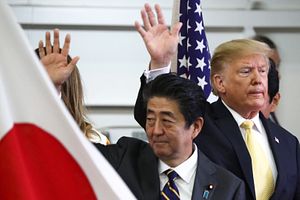Donald Trump today became the first U.S. president to board the Japan Maritime Self-Defense Force’s (JMSDF) largest flattop, the Izumo-class helicopter carrier JS Kaga, at the Yokosuka naval base south of Tokyo wrapping up the U.S. president’s four-day state visit to Japan.
Together with his Japanese counterpart, Prime Minister Shinzo Abe, Trump toured Japan’s largest warship on May 28 to demonstrate the strength of the U.S.-Japan alliance and to “send a message to China,” according to a Japanese government source. Trump and Abe were accompanied by their wives during the inspection.
Abe and Trump addressed a group of about 500 U.S. and Japanese military personnel gathered in the hanger of the JS Kaga. “This is the first time the leaders of Japan and the United States have visited together to extend their encouragement to the SDF [Self Defense Force] and U.S. military,” Abe said. “The fact that we are both standing here today is evidence of the strength of the Japan-U.S. alliance.”
Abe also talked about the JMSDF flattop’s recent operational history. “The JS Kaga sailed through a vast area from the western Pacific through the Indian Ocean last year, to deepen the cooperation with navies of regional partners in close coordination with the U.S. Navy,” the prime minister said.
“Our mission is to realize a free and open Indo-Pacific, and to establish a foundation for regional peace and prosperity.” The JS Kaga’s sister ship, the JMSDF helicopter carrier JS Izumo, conducted a number of naval exercises with allies and regional partners in the Indian Ocean and South China Sea.
Hailing the U.S.-Japanese alliance as “an incredible partnership,” the U.S. president in his speech on the carrier’s hangar deck noted that “this is the only port in the world where a U.S. Naval fleet and an Allied Naval fleet are working side by side with each other.”
Trump in his speech, also referenced the conversion of the Izumo-class into full-fledged aircraft carriers capable of launching the F-35B, the vertical or short takeoffs and vertical landings (STOVL) variant of the F-35 Joint Strike Fighter, as well as Japan’s decision to procure an extra 105 F-35s from the United States.
“Soon this very ship will be upgraded to carry this cutting-edge aircraft, Trump said. “With this extraordinary new equipment, the Kaga will help our nations defend against a range of complex threats in the region and far beyond.”
Notably, the U.S. president was expected to board the JS Kaga’s sister ship, the first-of-class JS Izumo during a state visit to Japan in October 2017. However, the visit did not take place.
Trump on May 28 also visited the nearby U.S. Yokosuka Naval Base, where he boarded the Wasp-class amphibious assault ship USS Wasp. The USS Wasp is the size of a small aircraft carrier and can carry around 31 aircraft including the F-35B. In a speech in front of around 800 U.S. servicemen and women, whom the president called “daring and mighty warriors in the Pacific,” he emphasized the need for additional guided-missile destroyers, submarines and F-35s.
Yokosuka is home to the headquarters of the JMSDF and also the home port of the U.S. Seventh Fleet, the largest of the U.S. Navy’s forward deployed fleets and consists of around 50-70 ships and submarines and around 20,000 sailors.
The president and the first lady of the United States, Melania Trump, were Japan’s first state guests in the new imperial era “Reiwa” following Emperor Naruhito’s ascension to the throne on May 1.

































